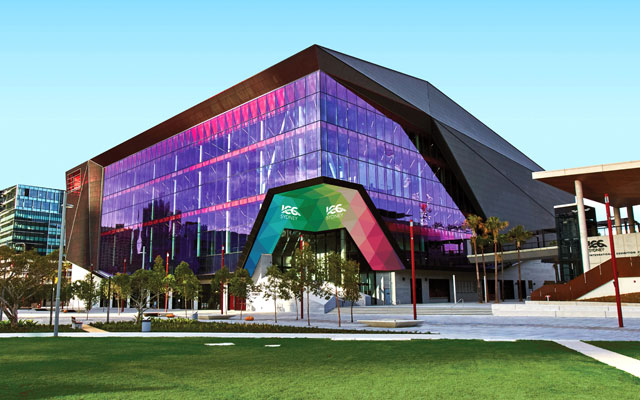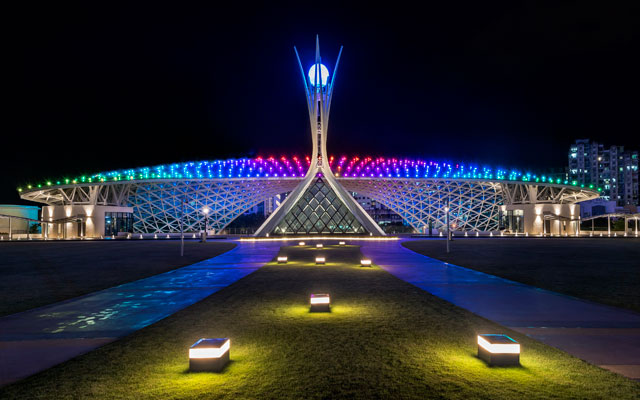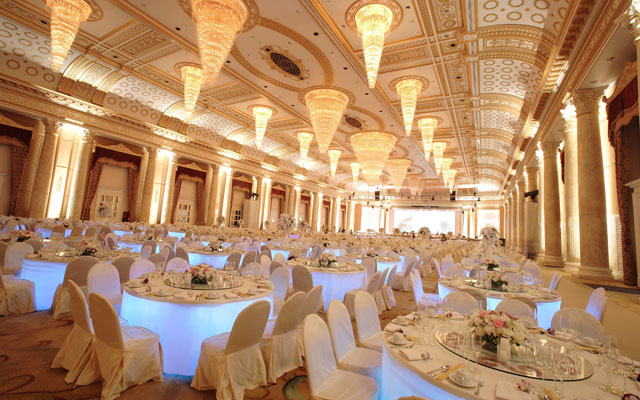Sniff out convention centres in the region that have paid careful attention to aesthetics and are reaping commercial benefits
AUSTRALIA
International Convention Centre Sydney
An eye-catching landmark in Darling Harbour, the International Convention Centre Sydney (ICC Sydney) is made up of three buildings, each different in design.
 Joint venture partners HASSELL + Populous that were behind the architectural concept, crafted the ICC Sydney Exhibition Centre with natural colours of greens, browns, whites and greys, with liberal use of wood, to reflect the surrounding landscape of Tumbalong Park; gave ICC Sydney Convention Centre a shimmery glass façade, a fitting match to the glistening waters of the bay nearby; and presented ICC Sydney Theatre in a futuristic manner with bold reds and blacks, perfect for the live music concerts the venue was designed for.
Joint venture partners HASSELL + Populous that were behind the architectural concept, crafted the ICC Sydney Exhibition Centre with natural colours of greens, browns, whites and greys, with liberal use of wood, to reflect the surrounding landscape of Tumbalong Park; gave ICC Sydney Convention Centre a shimmery glass façade, a fitting match to the glistening waters of the bay nearby; and presented ICC Sydney Theatre in a futuristic manner with bold reds and blacks, perfect for the live music concerts the venue was designed for.
Geoff Donaghy, CEO of ICC Sydney, said: “Convention and exhibition buildings have a tendency to be introverted by their very nature. In contrast, ICC Sydney was designed to bring a new dynamic quality and reputation to Sydney as one of the world’s most desirable business event destinations, enriching its knowledge and visitor economies.”
But ICC Sydney is more than just a pretty face. It houses an 8,000-pax theatre, 35,000m2 of exhibition space, a 5,000m2 open-air event deck, a 2,000-pax grand ballroom – the largest of its kind in Australia – and world-class theatres, meeting rooms and event spaces.
In total, the venue boasts over 240,000m2 of gross floor area and the unique configuration allows three major conventions to run simultaneously.
“ICC Sydney is a purpose-built digital venue which not only supports the needs of today, but has the capability to flex and adapt for decades to come across all types of events – big and small,” Donaghy added, pointing to the venue’s 10Gbps optical fibre backbone which had seamlessly accommodated more than 5,200 concurrent Wi-Fi users across 150 sessions during the annual Salesforce World Tour to Australia.
“Since opening in December 2016, the venue has received strong praise for its design, its in-depth collaborative pre-planning process and robust technology infrastructure, garnering more than 25 accolades recognising excellence across all facets of the business,’ he said. – Karen Yue
INDONESIA
Bali International Convention Centre
Bali International Convention Centre (BICC) was designed and furnished with a strong Balinese flavour, using carved timber columns, batik and local art works, giving the venue a sense of place in Bali.
Function rooms and halls throughout the centre sport a welcoming ambience, a stark contrast from traditional convention and exhibition spaces. The Exhibition Hall, for example, overlooks a manicured garden and has an internal staircase that leads to a gallery upstairs. The Cafe sits next door, offering event attendees a contemporary and relaxing space for light bites and refreshments. In this space also stands a stone wall carved by Balinese artisans to depict scenes from ancient Hindu mythology.
Other event spaces within BICC include theatre-style Mangupura Hall which can seat 2,500 people; the auditorium with 506 built-in seats, Bali’s only tiered theatre; 26 meeting rooms; two plush VIP holding rooms; and The Lounge, which comes with a fully-stocked bar that can cater to quality social gatherings.
Being located adjacent to The Westin Resort Nusa Dua has its perks, as BICC gains high-quality F&B catering support.
As well, event delegates can easily skip to the hotel’s Heavenly Spa by Westin for a post-meeting massage or keep to their usual exercise routine at the fitness studio, double tennis court and on-site running routes.
Saraswati Subadia, assistant director of sales and marketing for The Westin Resort Nusa Dua, said the venue often won an event bid with its “appealing environment” that planners are comfortable with.
“In our 27 years of experience in hosting small to large conferences and corporate to high-level government events, we have received many comments about our well-designed interior as well as varied support facilities,” she added. – Ade Siregar
JAPAN
Academyhills, Tokyo
Comfort is a key consideration at Academyhills, with facilities designed with the belief that delegates who are relaxed will be more productive and engaged.
Designed by world-famous architect Kengo Kuma, the conference centre occupies the 49th floor of the Roppongi Hills complex. The 559m2 Tower Hall can accommodate 500 delegates in a theatre layout, while the other nine event spaces can cater to groups of between 150 and 30 guests.
Roppongi Hills was created as an “artelligent city” – a fusion of art and intelligence – and Academyhills contributes to that as a space of “tranquil intellectual luxury,” said Keiji Kurahashi, senior manager of the Academyhills Forum Group.
“Delegates stay in conference facilities for several hours at a time and are often in a tense environment. And that is why we have incorporated visual designs of an appropriate scale and calm lighting while making the entire complex easy to navigate in order to reduce participants’ tension,” he said.
That concern for delegates’ well-being has extended to the creation of a unique chair. The WATT chair benefits from extensive ergonomic research to reduce discomfort and help delegates remain focused during long meetings.
To promote the sense of the conference centre serving as a knowledge hub, the Library Café and the hallways of Academyhills are flanked by bookshelves containing books on a myriad of subjects that can be perused by guests. Corridors are wide and dotted with comfortable chairs; the décor is warm and inviting.
Some 200m above street-level, the venue also boasts 360-degree views across the city – particularly spectacular at night – while event catering services are provided by members-only Roppongi Hills Club, which is housed in the same building. – Julian Ryall
MALAYSIA
Setia SPICE Convention Centre, Penang
Setia SPICE Convention Centre in Penang, Malaysia is recognised as the first hybrid solar powered convention centre in the world, and boasts a Green Building Index certification.
 Setting it apart from traditional convention centres is its vast open spaces that welcome events.
Setting it apart from traditional convention centres is its vast open spaces that welcome events.
The rooftop garden comprises three large areas: A children’s playground, a large well-manicured green lawn, and a Japanese inspired bamboo garden and spice garden. Spread across two levels, the rooftop garden allows attendees of large-scale events to flow freely in the open. It can host approximately 10,000 guests for a cocktail event.
It is worth noting that Setia SPICE Convention Centre’s has 654 energy efficient light bulbs which can be programmed to cast various colours and patterns to complement any event held at the rooftop garden. There is also an outdoor stage area.
Setia SPICE Convention Centre is one of five components of an integrated complex. The others are: Setia SPICE Arena, Setia SPICE Canopy, Setia SPICE Aquatic Centre and an adjoining 453-key business class hotel opening in 2020.
According to Yeoh Kheng Ho, senior manager, Setia SPICE Convention Centre, the interior design of any convention centre plays an important part in making the centre look grand and at the same time, peaceful, to visitors and clients. – S Puvaneswary
PHILIPPINES
Philippine International Convention Center, Manila
The country’s first convention centre was purpose-built for the International Monetary Fund-World Bank annual meeting 42 years ago when the Philippines was striving for global acceptance.
Located in Manila, Philippine International Convention Center’s (PICC) brutalist architecture and elegant interiors – magnificent chandeliers, wooden parquet flooring, grand staircases and priceless paintings and sculptures – set it apart from its newer counterparts’ futuristic and minimalist designs and metal-and-glass box structures.
Its elegance undiminished by time, PICC’s low-rise horizontal space is matched by vast outdoor spaces in the garden, courtyard and reflecting pools. Indoors are delegates lounge and executive lounge for relaxing in between meetings and conferences.
PICC general manager Renato B Padilla said: “Convention centres are no longer just about functionality, but also about beauty and aesthetics. Its layout and interiors, as with any venue, set the mood and ambiance for any event. A well-designed centre facilitates a smooth flow of communication – whether shared or confidential – in line with its primary purpose of being a place for exchanging ideas and networking”.
Padilla added: “However, we’d like to think that PICC is often chosen as an event venue not just for its well-designed interiors, but also because of its cultural and historical value.”
PICC’s fine dining restaurant, Amorsolo, is run by accredited caterer Via Mare. It even has a prayer room for attendees practicing their Islam faith.
Padilla said the modern museum of art and numismatic collections of the Bangko Sentral ng Pilipinas (Central Bank of the Philippines) will be completed in 4Q2018. Set within PICC grounds, the museum will also offer lecture rooms, a research area, a library and more.
To keep pace with changing market needs, the PICC Forum will be dismantled this year to make
way for the new Trade Exhibit Hall which will add more space for exhibitions and more function rooms plus pre-function lobbies, storage rooms, kitchen, loading bays and rentable commercial spaces. – Rosa Ocampo
TAIWAN
Kaohsiung Exhibition Centre
Kaohsiung Exhibition Centre is the Taiwanese city’s business events centrepiece. It sports an iconic wave design and enjoys a prime location on the Kaohsiung Harbour.
The building boasts an oceanview banquet room overlooking the marinas and Kaohsiung Port, and its halls are equipped with a simultaneous interpretation system that can translate between eight languages.
Beyond the meeting spaces, corridors are filled with dining, retail and art.
Its location also means delegates can easily break away from indoor meetings for rejuvenating strolls along the sea. Access is also easy through harbour cruises from the nearby terminal. For meetings with a twist, planners can hold breakout sessions at the nearby Pier 2 artistic area.
“(These) can all be easily integrated into the meeting itinerary, bringing inexpensive diversity to the programme,” opined group vice president Robert Campbell.
He added that such features have helped the centre draw in “more and more medical conferences”.
He explained: “Our venue works very well for sessions in different rooms, coffee breaks in others, sponsor booths in the aisles or other rooms, all on the same floor of a beautiful iconic building on the waterfront, with parking below and on-site kitchen for catering.”
The centre is part of the Kaohsiung MICE Alliance which comprises stakeholders from venues to academia. It will be the venue of the ICCA 2020 Congress. – Pamela Chow
THAILAND
IMPACT Muang Thong Thani, Bangkok
This integrated venue is one of Asia’s largest exhibition and convention centre, taking in IMPACT Challenger which comprises three interconnected halls; IMPACT Exhibition Center which houses eight multipurpose halls and six function rooms; IMPACT Forum, a standalone convention centre; IMPACT Arena with 11,000 seats; IMPACT Lakefront with 150,000m2 of outdoor space; and AKTIV Square with 19,000m2 of outdoor space.

The most beautiful gem in IMPACT’s crown is the Royal Jubilee Ballroom, said to be Thailand’s largest and most elegant column-free ballroom. Conical chandeliers, elaborate ceiling and wall detailing, and a plush carpet of warm shades lend a regal feel to the venue.
The careful attention paid to the interior design of IMPACT’s spaces are not just for aesthetic reasons; it fulfils commercial aims too – particularly in getting planners to sign the venue on for their events.
Loy Joon How, general manager of IMPACT Exhibition Management Co, said: “Our ballrooms and function rooms are comparable with hotel equivalents, which is important because our five-star facilities with elegant settings and amenities will add prestige to our customers’ events.
“The design (of IMPACT’s spaces) has helped us to be the preferred place for events.” Beyond these event facilities, IMPACT offers also places for visitors to have a little fun in between meetings. The Portal Lifestyle Complex, a four-storey building connected to IMPACT Arena, IMPACT Challenger and IMPACT Exhibition Center via well-designed link bridges, is packed with restaurants, shops and the 1,500m2 Portal Ballroom. Some of these restaurants have been used for corporate social events.
Outdoors, the IMPACT Speed Park beckons. Opened in December 2016, the karting facility comes complete with changing rooms, shower facilities, a briefing room, function rooms, and a winners’ podium. It will soon be joined by a waterpark.
Loy said: “Our recreational facilities enable us to offer our customers options to integrate business with pleasure. They can have a complete business and social programme under one roof.” – Karen Yue
SINGAPORE
Singapore EXPO Convention & Exhibition Centre
A sprawling complex in the east of Singapore, Singapore EXPO Convention & Exhibition Centre has the luxury of space and uses it well.
Its 100,000m2 of column-free indoor and outdoor spaces offer customisable halls and rooms, as well as a wealth of dining options.
It also offers a convention wing, MAX Atria, which takes in 12,000m2 of meeting space in the form of 32 meeting rooms and an outdoor rooftop space.
MAX Atria is Singapore’s first business events facility to receive the Building & Construction Authority’s Green Mark Platinum standard for its eco-friendly building design. The wing is surrounded by lush gardens and floor-to-ceiling windows.
“We take inspiration from how events are evolving. They are now in hybrid formats in order to engage attendees from all industries. Our halls and spaces are canvases of opportunity,” said Aloysius Arlando, SingEx Holdings’ CEO.
He raised the example of the carnival nature of the expo’s own event, the Singapore FinTech Festival. “We have different configurations and multimedia elements. We’ve also moved away from the two breaks/one lunch model, and brought in an all-day dining concept to let visitors eat and drink whenever they like.”
Another example is the recently held Regional General Managers Conference for McDonald’s China, for which a stage was transformed into a 360-degree spectacle.
“Event organisers are looking to venues to provide that added touch to help them make a truly ‘wow’ event and manage costs. We keep pace with technological changes, but we must also be a true partner to help curate and co-create events,” remarked Arlando.
The next big thing for Singapore EXPO, revealed Arlando, is relooking at its menu of offerings and anticipating new demands of organisers, such as all-day dining and inventive configurations of meeting spaces. – Pamela Chow
Suntec Singapore Convention & Exhibition Centre
Part of a shopping and office complex, Suntec Singapore Convention & Exhibition Centre has the advantage of placing event attendees in close proximity to a diverse spread of dining and retail options.
The centre boasts 42,000m2 of events space spanning over four levels, including two 12,000m2 multipurpose halls and 36 meeting rooms. These customisable spaces are equipped with movable, soundproofed walls and an Intelligent Building Management System that controls space configuration. As well, it takes pride in the use of integrated technology that enhances the event experience.
Arun Madhok, CEO of Suntec Singapore, said: “We are able to accommodate the demands of a fast-growing hybrid conference and exhibition market segment, which requires multiple rooms for exhibitions and conferences to be in the same area.”
Suntec Singapore also employs the use of cutting-edge systems such as Crystals-on-4, a customisable and energy-saving lighting solution; the ImmersiveAV Suite, a wide-format 105m projection screen; and The Big Picture, the world’s largest high-definition screen at the driveway of the centre.
“Setting the right mood for an event is crucial to creating the perfect experience for our audience… As one of the most digitalised convention centres, the launch of the ImmersiveAV has catapulted Suntec Singapore into another league. It uses technology to transform audience experiences, thus gaining us recognition among event organisers who are constantly under pressure to create more engaging experiences,” said Madhok. – Pamela Chow










